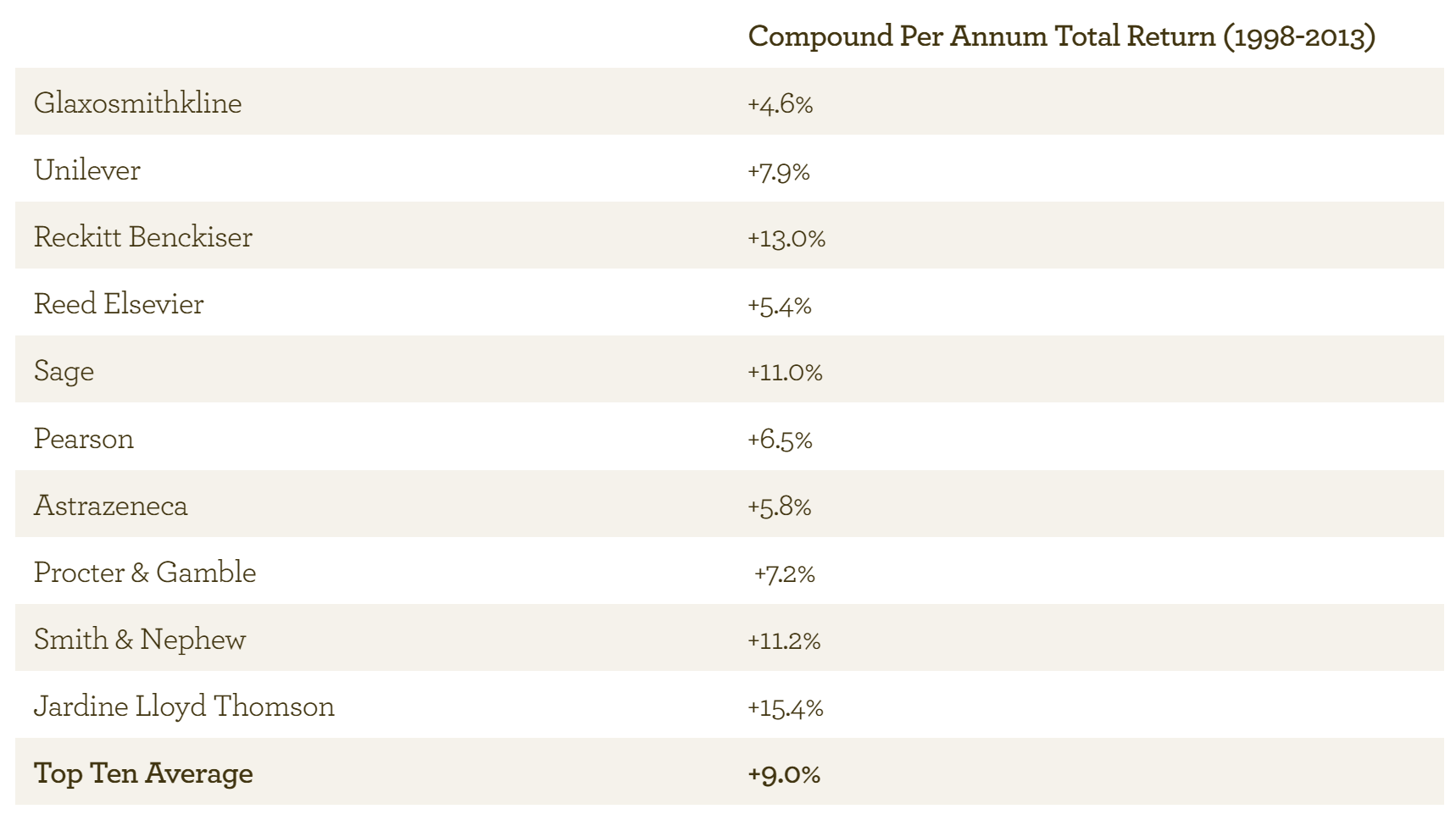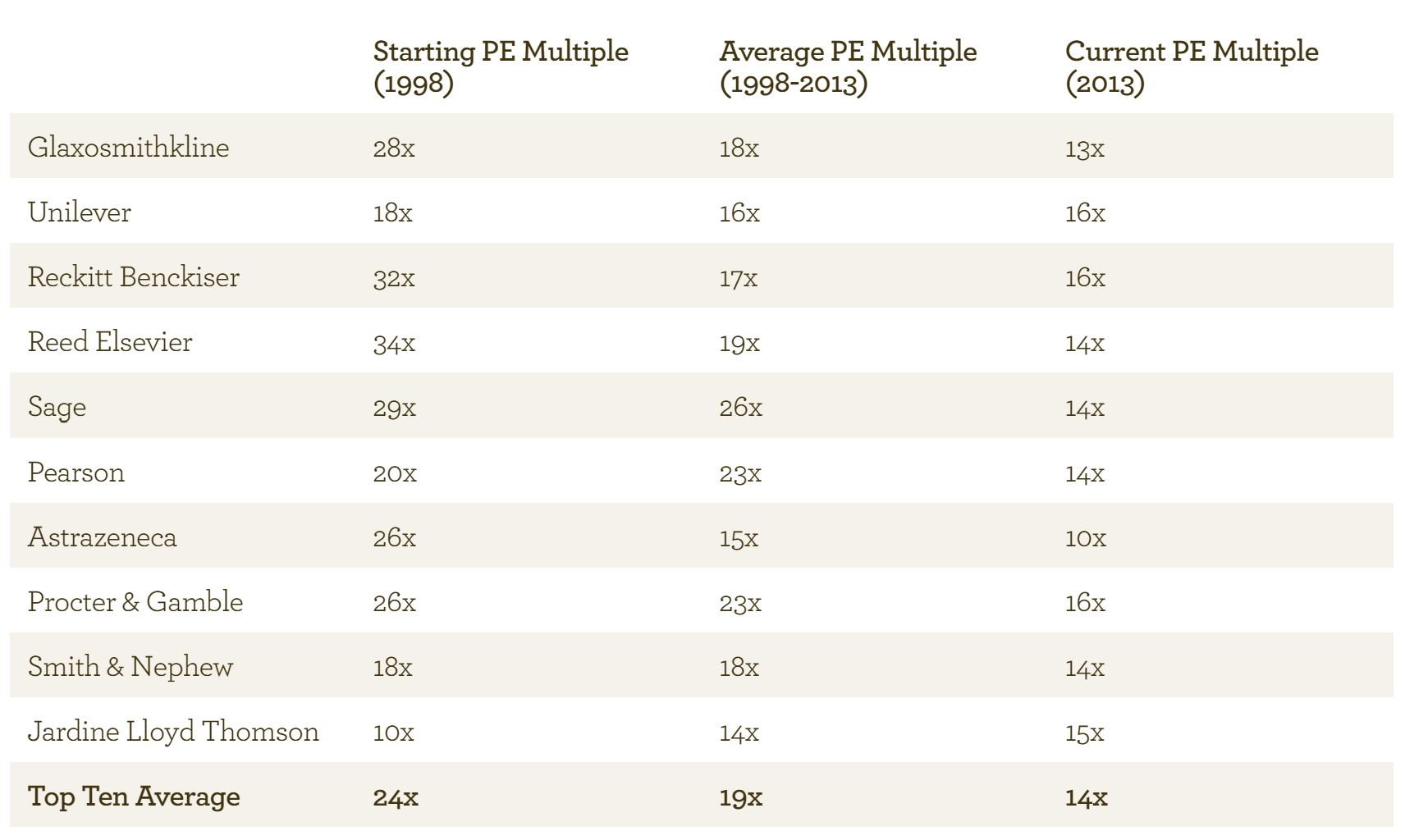Having risen sharply until May, global stock markets have made slower progress since the start of the summer, but a general sense of optimism still prevails. Back in August 2011, as the Eurozone hung by a thread, investors were running scared and all talk was of minimising risk. Now, only slightly more than two years later, animal spirits have returned and thoughts have increasingly turned to maximising return. Particularly noticeable over the last few months has been a growing interest in riskier shares. More economically exposed 'recovery' companies, especially those with a high level of domestic and US exposure have performed strongly, as have small and mid cap shares. In contrast, larger, less economically sensitive companies (‘defensive’ or more pejoratively ‘boring’ shares) have fallen out of favour.
Building An Innings
'Stay in, because you can't score runs in the pavilion.'
Geoffrey Boycott
As I have mentioned before, our approach may appear unnecessarily austere at certain moments, such as the last three months. But there is a good reason for this - we are keen to 'remain at the crease' through the full market cycle. Our approach is designed to avoid the investment equivalent of those cricket shots that end with a long walk back to the pavilion. Like Geoffrey Boycott, we look for low risk ones and twos and avoid making risky attempts at fours or sixes (when chances come along to hit a boundary with limited risk, then of course we'll take them, but the reality is they rarely do). We aim to do this by only owning quality businesses (companies with strong returns on capital and significant intangible assets), and only owning them when they trade on sensible cash-flow valuations.
So while the UK and US economies might return to strong growth over the next couple of years, they also might not. We are much more interested in insulating the portfolio from the full range of macro-economic risks than trying to forecast the next move in the global economy (up or down). While this means there will be plenty of excitement we won't participate in, we think it's a very effective way of managing risk over the full market cycle. And it is surprising how quickly the batting score notches up over months and years when holding a portfolio of fairly predictable high quality companies with sensible valuations attached to them. Time is the friend of these businesses. Their franchises persist and customers remain loyal, returning habitually to spend more. As a result, despite the defensive tag they often receive, the rate at which they can grow shareholder value long-term tends to be significantly higher than market averages.
Evenlode Top Ten Holdings - A Longer Term Perspective On Current Valuations
There is, in my view, a misconstrued notion amongst some investors that all or most 'quality' shares look rather overvalued in the current market. It may be true that these shares have on the whole outperformed the market over the medium term, but they generally do*, and it doesn't follow that this now leaves them overvalued. Consider the below table, for instance, which shows the compound total return per year from the top ten holdings in Evenlode over the last 15 years (since 1998):

This average return of +9.0% compares with the UK market's total return of +5.5% per annum over the same period. One might naturally suspect that this +3.5% outperformance was achieved with the help of a fair wind from rising valuations for the stocks in question, as their fundamentally good performance has become increasingly appreciated by the market as time has gone on. However, the converse is true. As the below table shows in a rough-and-ready fashion, these ten stocks suffered a near halving of their price to earnings (PE) multiples over the period (from 24x to 14x). Their outperformance was therefore achieved in the face of a very significant valuation headwind (the market experienced a valuation headwind too, but it was much less acute, falling from 18x to 16x over the period)**:

In summary, there is a big difference between outperformance and overvaluation. The fact that these stocks have outperformed over the medium and long term is a function of fundamental performance, not valuation. These ten stocks in aggregate grew their earnings and dividends on average by +8% and +9% per annum over this period.
An average PE multiple of 14x is a modest starting point for this collection of high quality stocks (on average they also sport a healthy dividend yield of 3.6%). Our estimates of future free cash confirm to us that current valuations continue to provide the prospects for good, positive compound returns for investors willing to stay involved for the next few years (the journey from here to there is unlikely to be in a straight line, of course!).
We think the fundamental outlook for Reckitts over the next 15 years remains very good. Nearly 70% of Reckitts portfolio is in the health and hygiene categories, both of which should see high growth over coming years. The steady build out of Reckitt's emerging market footprint will also help long-term growth. However, from its current valuation, Reckitts doesn't need to produce anything like the fundamental performance it produced over the last 15 years to generate attractive returns to shareholders over the next 15. It starts today on 16x, not the 32x it traded on in 1998. Thinking back to Boycott, fours and sixes aren't required from this starting point. A little volume growth, a little pricing power, and a little margin expansion will do the trick. If Reckitts can achieve this, cash-flow will pour out of the business and dividends will move steadily upward. Anything more would be icing on top.
As with Reckitts, Smith & Nephew continues to enjoy a strong competitive position, high barriers to entry in its industry, and the ability to convert steady earnings growth into excess cash-flow for shareholders.
Large Quality Versus Small Quality
So, to generalise, we remain of the view that there is plenty of opportunity in larger, high quality shares. As with the consumer branded goods and healthcare holdings, our positive views on media and technology holdings remain unchanged.
The area of our investable universe that we've increasingly struggled to find value in is the quality medium and small companies we follow. Despite the low current representation in the portfolio, it is interesting to note that these stocks have been a key driver of Evenlode's performance since launch (small and mid caps represented nearly 50% of the portfolio in 2009/10). Below are the top 12 most significant contributors to Evenlode's overall relative return against the UK market since launch (out of all the stocks we have owned). As can be seen, there is a good representation from smaller/niche businesses, many of which have been reduced or exited on valuations grounds.
1) Diploma (Sold out)
2) Domino Printing (Sold out but subsequently repurchased)
3) Diageo (Reduced but still held)
4) ITE Group (Sold out)
5) IG Group (Still held)
6) Reed Elsevier (Still held)
7) Halma (Sold out)
8) Unilever (Still held)
9) Coca-Cola (Reduced but still held)
10) WS Atkins (Reduced but still held)
11) UBM (Sold out)
12) Euromoney (Sold out)
Relative valuations at the smaller end of things have by no means improved over the summer (quite the opposite in fact). As a result, our shift away from these businesses has had no significant benefit so far. However, returning to the cricket analogy, staying at the crease requires patience and prudence, and many of these stocks no longer offer the margin of safety that we'd like to see.
Returning to the general discussion above, while Halma's strong performance has in large part come from strong fundamental earnings per share growth, it has also benefited from an increasingly high valuation of these earnings by Mr Market. We sold out of Halma in March as our estimate of forward cash return has dropped to a level that no longer looks attractive relative to other options. We are happy to sit on the side-lines for now, but this is a high quality stock we know well and would welcome back to the portfolio again in the future.
We will keep a close eye on valuation developments in the smaller companies we look at. We fully expect this part of our tool kit to play a more significant role again in the fund, at some hard-to-predict point in the future.
No Flashy Sales Pitch
To round off this monthly, I include the following quote from US investor Glenn Greenberg. I apologise to regular readers for repetition, but it is so relevant to the way we manage Evenlode that I feel it worth including again here:
"Few people are willing to concentrate their investments in a small number of businesses that they know thoroughly and believe will grow their net worth at an attractive rate over the long-term. Many days this work is just plain boring. Other days (and sometimes months), the market totally ignores your handful of precious stocks. A portfolio of predictable, reliable businesses does not make you the most exciting person at the cocktail party, nor does it give you flashy sales promotion material. I have come to believe the quest for rational investing is appealing only to a handful of us. But at least we sleep well at night and live well by day – and our clients do as well."
So no flashy sales pitch to finish on. But we reassert our commitment to invest our shareholders' savings (alongside our own) with patience, prudence, and objectivity.
Hugh Yarrow, Investment Director
19 September 2013
Please note, these views represent the personal opinions of Hugh Yarrow as at 19 September 2013 and do not constitute investment advice.
*Several studies have demonstrated this persistence of outperformance from high quality shares over the years. E.g. Profits For The Long Run: Affirming The Case For Quality, Chuck Joyce and Kimball Meyer, GMO, June 2012.
** All PE data used in this commentary is based on one year forward earnings. Source Canaccord, Financial Express, Wise Investment.